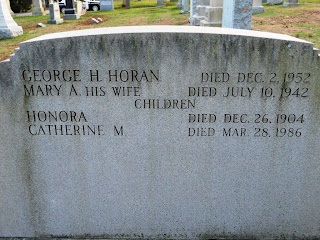John Horan was born in Galway, Ireland in 1827. He immigrated to the United States in 1845 during the peak years of the Great Famine emigration out of Ireland. Fall River, Massachusetts held significant appeal to the large numbers of immigrants seeking work and a new life in America. During the growth of the industrial textile mills, Fall River boasted over 100 textile mills and employed an estimated 35,000 people. The town population peaked in the 1920’s well over 120,000 people. 2010 census population figures show Fall River has about 88,000 residents.
About 1850 John Horan married Catherine O’Neil. Together they had six children. John Horan’s occupation is listed as a laborer (per Uncle Bill Horan, he recalls the family said John Horan was a fisherman) while Catherine stayed home to care for her family. As was typical during this era, many of the children worked in the mills and were employed at Globe Textile Mills and American Print Works, two of the largest of the factories (photos posted below). Meager wages meant long hours and mill families often worked together at the same factories to support the household.
Photos from Ambrose F. Keeley Library/the Information Center of B.M.C. Durfee High School
The family was listed in the US Census of 1880 and 1900 as residing on Beach Street. This south end section of town was built to house the thousands of immigrant workers who flooded the factories. Tenements would be built in three-story multiple levels to house the growing labor force and their families. The years John Horan arrived and established his family and livelihood is important from a historical aspect. The fact that he overcame the adversities of two, maybe three countries (Ireland, United States and possibly England before embarking for America) should give us all a moment of reflection. Where you are at this moment in your own life and that of your children is built upon the courage, hard work and sheer will to survive from John Horan and his descendants.
The Horan-Doran family tree by Jim McCarthy is available. Send a message if you would like a copy. The image below is from the research I am building on specifically the John Horans. He is at the top of this Horan tree and is the first immigrant to arrive in the United States in 1845, hence he is our marker for Generation 1. I have found more vital information on John and Catherine Horan and will do another post regarding them at a later date. If you are a family member, your ancestors descend from John and Catherine and one of his six children. Lastly, a minor correction to the Horan-Doran family tree file. The eldest son, John William, is not listed. He shows up on earlier US census data but not not later, which might mean he left the home for work while the rest of the family remained on Beach St. William J., as he was called, died after his father in 1910 and is buried alongside his parents and one of his brothers who died young. (--I reposted the tree image. Days after this was completed, more documents were found and John Horan's parents in Ireland were identified. I have added them to the image below.)

- article from the
Herald News, February 26, 2003, p. 12, with an additional article "Robert Irving Was City's First Irish Immigrant."
Here is the US Federal Census –Year 1880 . John Horan and the family are listed in lines 3-10. They lived on Beach Street in a couple residences until John Horan’s death in 1905.
 An Irish Proverb
Is gaire cabhair Dé ná an doras.
An Irish Proverb
Is gaire cabhair Dé ná an doras.
God's help is nearer than the door.















